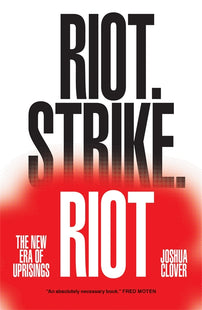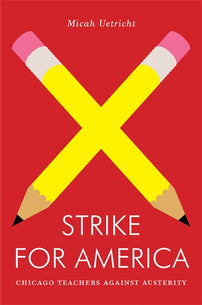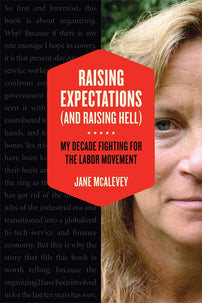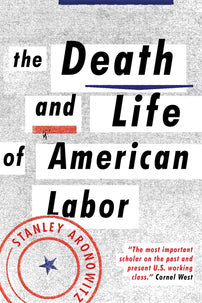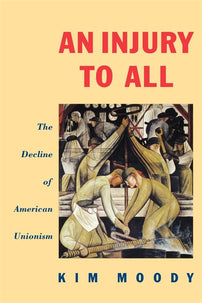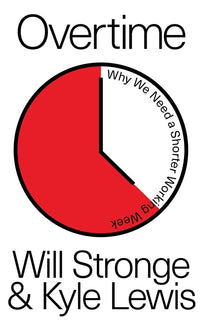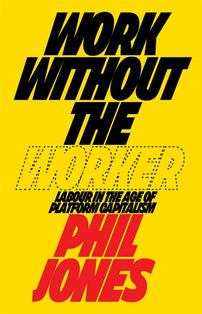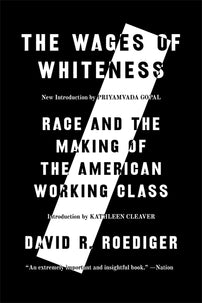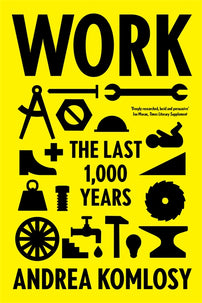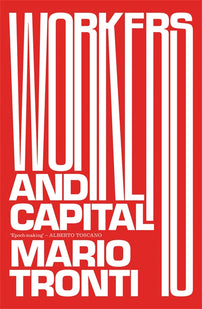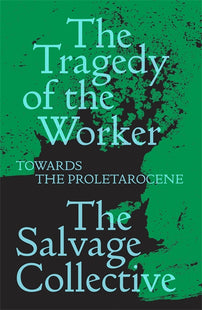US Labor On Strike: An Interview with Jonah Furman
Jonah Furman talks Striketober, the US labor movement, and the future of neoliberalism in this in-depth interview

Interview with Jonah Furman by Michal Schatz
Jonah Furman is an organizer and labor journalist at Labor Notes. His coverage of the ongoing US labor strikes has elevated workers' voices and demands, as well as provided critical insight into today's labor movement. In addition to his reporting, Jonah Furman also publishes a weekly substack called Who Gets the Bird? where he provides a detailed breakdown of key developments in organized labor across the United States.
***
Normally this question goes at the end of an interview, but I want to make sure readers see it, so -- for those of us looking for ways to support these struggles at John Deere, Kaiser Permanente, amongst hospital workers in Buffalo or telecoms workers in California, what’s the best thing we can do and where should we look to do it?
What people usually mean by this is, “Can I give money to the strike?” Sometimes the answer is yes, sometimes no. Here’s where you can give money to Deere strikers, here’s the link for Kellogg’s strikers, here’s the link for Steelworkers at ArcelorMittal in Ohio. Here’s a semi-updated list of these links as funds pop up (I don’t run this or know who does, but these all look legitimate to me).
And while strike funds and solidarity funds are important, the most important thing you can do in the medium to long term is to organize your own workplace. Union workers in this country have a target on their backs because they are the only ones left standing with decent healthcare, decent wages, and some rights on the job. If more people organize, it takes some of that pressure off of the last ones standing.
You’ve been reluctant to embrace the “strike wave” hype that accompanied October’s labor action, pointing to its smaller scale in relation to the major twentieth century strikes and even to the 2018 public sector strikes. Why do you think both observers and the media have been tempted to draw comparisons between today’s private sector strikes and some of the highwater marks of American labor history (e.g. 1919 and 1945-6)? What makes this wave different from those moments, not just quantitatively but qualitatively?
I have gone back and forth on whether or not this is a “strike wave.” For one thing, that’s just an imprecise term. I think what is meant most classically by it is the contagious self-activity of workers. This was undeniably the case in the red state teachers strikes of 2018. Arizona, Oklahoma, Kentucky; these states struck because West Virginia struck, in a direct line. Of course, they were drawing from the same well of a decade of austerity post-2008 and declining conditions for public education workers, but there was conscious and explicit copycatting: that’s a true strike wave.
What I think is most interesting about this moment of is-it-or-isn’t-it a strike wave is that two years ago, in late October 2019, there was a moment of something like 85,000 workers simultaneously on strike (the bulk of this being the GM strike and the Chicago Teachers Union strike). Compare that to this year’s “Striketober” maxing out at something like 22,000 workers simultaneously on strike. And yet, 2021 gets called a strike wave. Now one way to understand that is simply that there’s a very low level of labor literacy and the media was looking for a story and found one; hype, in other words. Another way to understand it, though, is that a “strike wave” isn’t just about arithmetic; you don’t just add up the number of workers on strike and if it crosses a certain threshold you’ve got a certified strike wave. What’s notable about this fall is that the strikes are being connected to a political and social moment, and are seen as a manifestation of broader societal trends within the workplace and within the unions. So even if the quantity of strikes doesn’t compare to previous moments, the quality of the strikes feels politically and socially relevant. And that’s true from the outside looking in (the media, the public sentiment towards the strike) but also the inside looking out (the self-conscious identification with the term “essential worker”). This “strike wave” is seen as the working class reckoning in some way with national crisis and its political, social, and economic fallout, and in that way is similar to our post-war strike waves. It’s not similar in its scale or economic power. These strikes are being driven by inflation and economic pressures more than they are driving them; they are in no way large enough to exert economic influence per se, which I think the post-war waves definitely were (I’ve heard figures like one in 10 workers struck after World War II, one in five after World War I).
[book-strip index="1" style="display"]You’ve spoken elsewhere about the significance of John Deere workers’ (along with those at Kellogg’s and Kaiser) efforts to abolish the tiered wage system. What is the tiered wage system and why is it so harmful to organized labor? Why do you think workers across industries are so motivated to revoke tiered-wage right now in particular?
A “two-tier” system is any workplace arrangement where one group of workers has worse wages, benefits, and/or working conditions than another set of workers doing the exact same work. Most commonly, what differentiates the workers is just their hire date. These tiered contracts usually make their way into a workplace through a unionized workforce ratifying a contract that preserves conditions for the existing set of workers, but essentially sells out anyone hired after that contract is ratified.
There are two ways in which two-tier (which is really a shorthand for any tiered contract) is particularly harmful. One is that it’s a race to the bottom within the workplace. When one set of workers are far cheaper for the company, the company will do whatever it can to reduce or eliminate the higher-tier workforce. So by voting in two-tier agreements, you’re preserving what you’ve got, but you’re also putting a target on your back. But more insidious even than that is the way in which two-tier divides workers and their unions. As tiers get further and further apart in material experience of the job, their interests in contract negotiations, in day-to-day shop floor fights, in all sorts of traditional functions of unions, diverge. Unions’ strength is in their numbers, and two-tier divides the workforce in ways that make collective action that much harder.
At John Deere, which went harshly two-tier in 1997, before most of the rest of the United Auto Workers union (the Big Three -- Ford, GM, and Chrysler (now Stellantis) -- only went intensely two-tier in 2007, though there were earlier tiered arrangements), pre-97 workers enjoy post-retirement healthcare and livable pensions after they retire, and for years enjoyed better healthcare on the job and far better wages (though those on-the-job gaps have mostly been closed, though very few pre-97s still work at Deere). What we’re seeing now with the push to abolish the tiers is in some sense a moral sea change attributable to a broader political moment, but it’s also just the quotidian fact that the post-97s make up some 95+% of the union now, so there is unity around closing the gaps between the tiers. For years, there was not this kind of unity around targeting the tier system head-on, probably in part because the top tier workers weren’t all that fired up about it. They had theirs.
But I do think the broader political context is part of it. Two-tier was in some ways the distillation of labor’s response to neoliberalism. Concessionary bargaining more broadly (and labor-management partnership as its corollary) took hold in the fiscal crisis in NYC in 1975 and then was really brought to the private sector after the Volcker recession, the Chrysler bailout, and the PATCO offensive by Reagan and his lieutenants at the Business Roundtable. It was labor’s way of surviving that moment, and labor has not fundamentally broken out of it, though it has spread quite unevenly. At my most hopeful, I wonder if the cracking of the two-tier status quo within the labor movement is not a reflection of the cracking of the neoliberal status quo more broadly.
The last time John Deere workers went on strike was at the height of Ronald Reagan’s second term in office. Among the goals of today’s strike is an effort to revoke key neoliberal innovations to union contracts, including the weakening of worker pensions and the creation of a tiered wage system. Some people on the left have argued that Covid has initiated the demise of traditional neoliberal politics and state practices. Looking at today’s ongoing labor struggles across the US, do you see proof of this analysis? Has the pandemic changed the way that these striking workers perceive the value of their labor?
I have yet to be convinced that we are at any generalized turning point in our broader political system; yes, the Democrats’ crisis response is different in degree from that of 2008, but doesn’t seem to be different in kind; whether the social programs initiated during the height of the crisis will be extended and institutionalized would be one major indicator that we are in fact in a different moment. But I hear the same talk of debt, inflation, limited, targeted interventions, and talk of but not action on the sorts of more lasting reforms that could shift power in the labor market, for example. On the union side of things, I think there has been much more space created for different kinds of responses to the crisis, but it’s early yet. The fact that workers are using this moment of crisis to question a longer-standing labor movement status quo, like two-tier in particular and concessionary bargaining in general, is heartening, but may well be fleeting. It’s also the case that state action so successfully insulated many corporations from the worst effects (or just that the effects of the crisis were so uneven) that in many of these fights we’re just not dealing with austerity conditions, which would be the real test of this new mood. A big part of the context for the Deere fight (and the Kaiser fight, and others) is that there’s a lot of money on the table. Fighting for a bigger piece of a bigger pie is different from protecting or making gains in a generalized downturn. Though UNITE HERE’s mixed success on “right to return” rules are a slight counterexample.
The current John Deere strike is part of a long history that spans the neoliberal era. For many of the company’s striking workers, the 1986-7 strike is not an abstract historical fact, but part of their own lived experience, whether as younger workers themselves or as the children of workers who participated in that strike. Deere workers’ unexpected rejection of the first 2021 proposed contract in early October was about more than immediate material needs and demands -- it was about fighting to win back benefits lost through concessions in the 1997 contract and preventing the expansion of the tiered wage system. What does this strike mean to the workers you’ve spoken to?
One under-appreciated fact of this strike is that while, yes, it’s about ending two-tier (and about beating back a third tier proposed by the company), there are very, very few top-tier workers left at the company. So the challenge of returning all workers to the top tier is less about the actually-existing divisions between active workers and more about what the company can afford. Hundreds, if not thousands, of Deere workers are second- or third-generation at the company, so they have direct knowledge of what a Deere retirement used to mean. The fact that Deere is currently more profitable than it's ever been, even when adjusted for inflation, is part of the calculus for these workers. If ever there were a time when concessions could be rolled back, wages brought back up to pre-97 levels, and retirement security locked in, it’s now, if you just look at Deere’s balance sheet. What’s interesting is that it’s not like the 1997 tier is new (obviously), or newly odious, but for the first time a majority of workers voted down a contract for not addressing it, which obviously no prior contract had substantively done either. I’ve seen some people say that even the strikes we’re seeing are defensive -- and that’s true in the case of the third tier Deere proposed -- but I actually think by rejected the second contract (that had already killed the third tier, doubled the raise, and boosted the pension), these Deere workers are self-consciously going on offense; that’s a big change for the private sector labor movement in general and these workers in particular.
The UAW rank-and-file’s overwhelming rejection of the first tentative agreement last month surprised and excited many observers on the pro-union left, but what was the UAW leadership’s reaction? Do you have a sense of how the top brass of the union movement is thinking about this moment, how they understand it? How closely do the slogans and/or demands coming from the rank-and-file resemble the leadership’s position?
The question of leadership in the UAW right now is a particularly sharp one. On the national level, the UAW is going through what federal prosecutors have characterized as the biggest union corruption scandal in US history, with millions of dollars being embezzled, but even more importantly, top officials having been bribed by Fiat Chrysler (now Stellantis) for bargaining concessionary contracts. This has led to intervention by the Department of Justice, which, along with prosecuting over a dozen top UAW officials, has mandated a referendum on how the union elects its top officers, to bring an end to decades of one-party rule by the “Administration Caucus” that has bred a culture of corruption. How this has impacted the Deere negotiations is a little more complicated; broadly there is a sense among the ranks that the “International” (as opposed to the local unions) is at best compromised and is at worst suspect. The last contract negotiations, in 2015, were led by Norwood Jewell, a UAW official who subsequently served time in prison for corruption, and that is not abstract to Deere workers who feel their interests have not been fully represented at bargaining.
It is unusual for a recommended agreement to be voted down by such huge margins, and multiple times, as has happened at Deere, but it is not the first time this year the UAW has seen something like this. In the spring, Volvo workers in Virginia repeatedly voted down a contract that was then simply called up for a revote until they ratified it. That doesn’t happen in a union where the ranks and the negotiators are on the same page; contracts get voted down somewhat frequently, but not usually by overwhelming margins, and not over and over. The local unions are in a somewhat different position from the international; for the most part they haven’t been directly implicated in the corruption scandals, and, in the case of Deere, many of these local officials are relatively new to their posts, have recently worked in the plants, and there’s a culture of them returning to the job after a few terms in office at most. So one of the puzzles at Deere has been how these local officers, who make up a majority on the bargaining team, allowed an agreement to be brought back to the membership that was so out of touch with the members’ mood. Either the international had a much, much stronger hand over the locals in negotiations than the head count would have you believe (I think this is most likely the case), or the local leaders are as out of touch with their members as the international officers are.
The UAW strike is taking place against the backdrop of a grassroots effort to significantly democratize the union’s leadership election process by reforming the current electoral college-like system to a direct membership election. Has the strike activity generated any further excitement for the internal contests for leadership or democratizing reforms to union structuctures amongst UAW members? Is the UAW’s effort to democratize its leadership inspiring similar efforts elsewhere?
I’ve spoken to many Deere members who are newly energized around the referendum; for the most part, members who had come across a ballot (the vote was extremely poorly advertised, presumably intentionally, by the union leadership) were voting to switch to direct elections of top officers. But coinciding with negotiations and contract rejections and the strike meant that members were connecting the dots from a relatively abstract notion of union democracy at the very top to an incredibly concrete experience of fighting the boss. I’ve heard from several Deere strikers who plan to join UAWD, the organization of rank and file UAW members that is most vocally organizing to win the referendum, which they hadn’t even heard of before the strike.
As for inspiring efforts elsewhere, it’s hard to say. Direct elections of top officers in international unions is not unheard of, but it’s not common, and has usually been implemented due to a consent decree (as was the case in the Teamsters in 1989, and the Laborers in the 90s, and, possibly, the UAW in 2021). So it’s not like members of, say, the AFT, can just switch to direct elections of top officials tomorrow. What’s more, for members who are disengaged from the national goings-on of their unions (for many members, the “union” is functionally just their shop steward, union rep, and/or local executive board), it can be hard to make the case that some big procedural fight is necessary to achieve what they actually want, which is power on the job and at the bargaining table.
Obviously the Teamsters election happening concurrently with the UAW referendum is a pretty powerful demonstration of the importance of national union democracy, and all the moreso if the Teamsters for a Democratic Union-backed slate wins (as it looks increasingly likely they will) and is able to build a real contract campaign at UPS, the largest private sector union shop in the country.
[book-strip index="2" style="display"]You and Gabriel Winant recently highlighted the increased proximity of labor and political demands that’s developed in recent years. This is a considerable departure from the last several decades (and even before) in which even militant industrial action was quite circumscribed and generally conceived of as separate from politics more broadly. In fact, the largest strike waves and highpoints of industrial militancy in the twentieth century did not yield to the creation of a new mass political organization, produce an immediate re-alignment of party politics, or even form what Mike Davis calls an “embryo of a new working class ‘culture” that would extend beyond fragmented social identities. What do you think accounts for this strengthened relationship and what do you think its implications are for both electoral politics and organized labor?
I think we’re far from an actually organized political expression of what’s happening in the labor movement; the labor movement, like the rest of us, remains trapped in a structural terrain of the two-party system, with no short-term recourse, except through intra-party fights that the vast majority of the union movement still remains apparently too cautious to wage in earnest. There is not yet a counterpart to the “squad” in the labor movement’s political action wing, let alone something more developed.
That said, I do think there is more political valence to some of the labor action now than some larger labor actions in the past. As I mentioned above, I think it has to do with the fact that the activity is seen as connected to a social and political moment, primarily through the lens of the pandemic and the “essential worker.” My sense is that very few people could say what the 2019 Stop & Shop strike was about, for instance, though it was a large, militant strike. It seems there is a more common understanding that the Deere, Kaiser, IATSE, Kellogg’s, Nabisco, Frito-Lay, and other high profile private sector labor fights are about the status of the essential worker, and, to a lesser extent but still there, about overwork and the “two-tier” concept. Those issues are directly connected to things the President talks about on a daily or weekly basis, and bills that Congress has been considering for months, as well as the “Great Resignation” and worries about a tight labor market. From local news to social media to political thinkpieces, everyone is sort of operating in the same frame as these strikes and strike threats, or at least in some kind of Venn diagram.
Social media is flooded with memes of people quitting their jobs and employers struggling to find new hires. It’s clear that the lower rungs of the labor market are so tight that it’s providing workers with leverage and confidence both within union jobs as well as outside them, in actions both individual and collective. What’s the relationship between these individual actions and more organized resistance, and is there any chance that these tremors taken by countless individuals could take a more cohesive, collective form?
I think it is underappreciated the extent to which the high-profile strikes and strike threats have all been undertaken by unionized workers. This may seem like a given, but the fact that it’s a given explains the moment we’re in. We have yet to see Walmart workers, for example, walk out or extract major concessions through collective action, despite being a huge workforce, despite being essential workers, despite working for a high-profile, profitable employer. So that’s the first thing to say about the difference between “Striketober” and “the Great Resignation.”
On the other hand, the resignations are far larger; in the scale of millions, rather than, at most, tens of thousands on the strike side. One of the questions I have is the role that that sort of mass activity, unorganized, uncoordinated, and narrativized by people other than the workers themselves, can play in class formation. In other words, even without organization, can workers make meaning out of quitting, even as an individual act? Can it become the basis for a broader challenge to the way we work in this country, or is it just about cutting a better deal with a different master? That’s part of the power of union organization. Your problem is my problem, and we understand ourselves to be acting together in our shared interests, which are opposed to those of the bosses (if not capital writ large). It transmutes individual experience into collective understanding; can the mass quit do that?
Because ultimately these strikes rarely have the scale to exert actual economic pressure on an entire industry, let alone the entire labor market. They’re just too small, and they will likely remain too small for a while, as the working class remains 95% unorganized in the private sector. But through organization, they can consolidate gains and build on them; strikes build a muscle that can then be put back to use in the future.
Are you following more technocratic debates about inflation, raising interest rates, etc, and other technical measures to loosen the labor market which has given workers so much more confidence? How should labor and aligned movements position themselves on the front of ‘big politics’ and economic policy? And assuming some of these measures do come to pass – higher interest rates for instance, restricted access to credit, curtailment of benefits, etc – how can we continue to maintain the initiative shown by workers through this year and last month especially?
I find it hard to talk about how our movements should act when they’re just so small and these decisions of strategy feel like putting the cart before the horse. Obviously it matters what we say we want to do once we are able to do something, but without some serious uptick in class formation, in workers understanding themselves as a group, and especially some serious strides forward in the scale of organization, both in strict union terms and in political action more broadly, these questions of policy are mostly academic.
